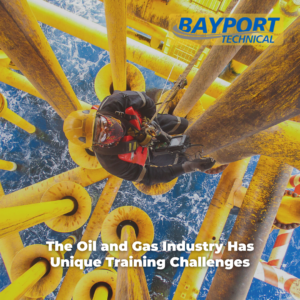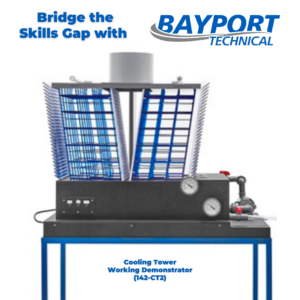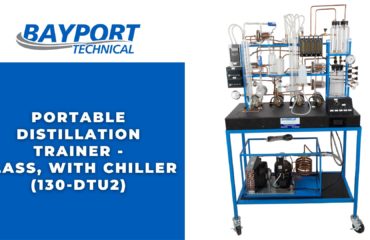
Click HERE to view Four Factors Contributing to the Oil and Gas Industry Skills Gap as a multimedia presentation.
The COVID-19 pandemic and its continuing aftereffects have shined a spotlight on the job market in the United States. Unemployment numbers remain high, yet we see “Now Hiring” signs everywhere we look. What’s going on?
In many industries, there exists what is commonly called a “skills gap” that accounts for the number of open, unfilled positions. This gap refers to the difference between the number of highly-skilled workers that employers need and the number of such workers available.
Nowhere is the skills gap more noticeable than in the oil and gas industry. As Vivek Kumar notes in an IndustryWired article, “[m]any industry professionals believe that a growing skills shortage has been the biggest challenge for the industry.”
According to a Rand Corporation study, the industry will require a “projected 1.9 million future oil and natural gas workers.” Because of the skills gap, hundreds of thousands of those positions could remain unfilled.
In this article, we’ll take a look at four factors contributing to the oil and gas industry skills gap, including an aging workforce, advanced technologies, reluctant millennials, and training challenges specific to the oil and gas industry. We’ll also examine the role training plays in bridging the skills gap, as well as how Bayport Technical’s training solutions prepare workers for success in the oil and gas industry.
An Aging Workforce Takes Critical Skills and Experience with Them When They Retire
 In an ideal world, aging employees close to retirement would help to train new, younger workers to take their place, passing along valuable knowledge accumulated from their years of experience on the job.
In an ideal world, aging employees close to retirement would help to train new, younger workers to take their place, passing along valuable knowledge accumulated from their years of experience on the job.
Unfortunately, that is not happening as frequently as it should in today’s oil and gas industry. Too many workers are reaching retirement age in the near future, and not enough new workers are filling open positions to replace them.
As noted by Jake Wengroff in a Synapse article, “[t]he average age of workers in petroleum companies is 50 years old, among the oldest of any industry…Now more than ever: with an increase in the number of experienced individuals retiring, the energy industry is facing a shortage of trainers capable of mentoring the next generation.”
A Grainger article summarizes the effect this is having on the oil and gas industry skills gap: “[m]any oil and gas companies have large segments of their workforce who are able to retire in the next few years. As these experienced workers leave, companies will have to bring in new employees and contractors who are less experienced and unfamiliar with the facility.”
New Technologies Are Transforming the Oil and Gas Industry
 Adding to the skills gap problem is the fact that, according to Kumar, “[t]he oil and gas industry is rapidly moving towards digital transformation.” This is not surprising, as new technologies like artificial intelligence, data analytics, and the Internet of Things are transforming industries of all kinds around the world.
Adding to the skills gap problem is the fact that, according to Kumar, “[t]he oil and gas industry is rapidly moving towards digital transformation.” This is not surprising, as new technologies like artificial intelligence, data analytics, and the Internet of Things are transforming industries of all kinds around the world.
The result is that today’s oil and gas workers need more advanced skills than ever before. As Wengroff notes, “[e]xploration, refining, and distribution of oil and gas and alternative energy sources have become complicated processes, as new technologies are introduced to maximize production.”
Workers without the requisite skills must either be replaced or retrained. According to the Rand Corporation study, “[a]s manual skills become less valuable than the technological ones needed to operate the emerging forms of equipment that are characteristic of this sector, many workers with obsolete skills are being displaced.”
The Rand Corporation study concludes:
“The gap between employer needs and employee skills is widest in the near term, when more jobs will open up than the current output of graduates is likely to meet, retirements will increase among the baby-boomer generation, and reliance on technical skills in the workforce will continue to increase.”
The Oil and Gas Industry Is Having Trouble Attracting Millennials
 Attracting workers to the skilled trades has always been an uphill battle. Ask anyone in manufacturing and they will tell you it’s a constant struggle fighting misconceptions and negative perceptions of industry jobs.
Attracting workers to the skilled trades has always been an uphill battle. Ask anyone in manufacturing and they will tell you it’s a constant struggle fighting misconceptions and negative perceptions of industry jobs.
The oil and gas industry is no different. In fact, it probably faces even greater challenges than other industries, because many young people tend to perceive oil and gas jobs as hot, dirty, difficult, and even dangerous.
Clearly, if the skills gap is to be bridged, more effort must be made to increase the number of new workers choosing the oil and gas industry. As Kumar notes, “[c]reating job opportunities for young professionals can be an effective approach to lessen the shortage of talented workforce in the oil and gas sector.”
However, no one believes this task will be easy. In fact, there are even newer concerns to address when it comes to millennials and the oil and gas industry. According to Kumar, “[m]any reports reveal that millennials are tentative to make a career in the industry. This is significantly because of the concerns around the consistency of the industry in the future, contributing to a workforce shortage in the industry. As millennials are becoming more tech-savvy, they want to work in innovative and evolving green energy industries.”
The Oil and Gas Industry Has Unique Training Challenges
 Further compounding the skills gap problem is the fact that the oil and gas industry has unique training challenges. This issue particularly comes into play when thinking about both upskilling incumbent workers and getting new workers up to speed with the skills they need to succeed.
Further compounding the skills gap problem is the fact that the oil and gas industry has unique training challenges. This issue particularly comes into play when thinking about both upskilling incumbent workers and getting new workers up to speed with the skills they need to succeed.
According to Kumar, “[t]he major reason the oil and gas industry faces skills deficiency are numerous training challenges, including regulatory compliance mandates, training costs to an aging workforce and the need to improve production rates while reducing environmental impacts and safety accidents.”
Wengroff points out that, “[a]s the energy industry grows more significant, and new participants enter the value chain, training is vital.” However, the author notes that this doesn’t mean training gets the attention it deserves, because “[s]pending time in instructor-led training sessions takes away from engineering, design, exploration, distribution, or retail marketing activities.”
Wengroff concludes:
“As with other industries, energy companies face a shortage of resources allocated to training. This may seem paradoxical, given the multi-trillion-dollar size of the oil, gas and alternative energy industry. However, with most funds going to exploration or the development of new technologies for extraction, refining, and distribution, training budgets are considered overhead and are often greatly reduced in size.”
Effective Training Can Bridge the Oil and Gas Industry Skills Gap
 As we’ve discussed, there are multiple factors contributing to the oil and gas industry skills gap problem. How do you solve a lack of highly-skilled workers? The obvious solution is to ensure that prospective and current workers have the advanced technical skills they need.
As we’ve discussed, there are multiple factors contributing to the oil and gas industry skills gap problem. How do you solve a lack of highly-skilled workers? The obvious solution is to ensure that prospective and current workers have the advanced technical skills they need.
Of course, putting that “simple” solution into practice is never as easy as it sounds. For example, many employers fail to invest in proper training because they feel like that responsibility should fall on the shoulders of educators at the secondary and post-secondary level.
However, that attitude won’t get you far in the oil and gas industry. With unique safety and regulatory compliance issues aplenty, the oil and gas industry simply cannot ignore the need for effective on-the-job training.
Consider these figures from the Rand Corporation study:
“About half of employers (52 percent) reported employing high-priority occupations that require moderate-term on-the-job training (including inspectors, welders, and roustabouts) and about one in four employers (28 percent) reported having high-priority occupations that require long-term on-the-job training (including mechanics, machinists, and wellhead plumbers). Thus, for many…oil and gas sector employers…it is essential to invest in and commit to providing on-the-job training to ensure their workers can adequately perform their duties.”
Moreover, it’s clear that prospective and current employees want and value ongoing training opportunities. Wengroff discusses this fact in his article:
“According to research conducted by the Society of Petroleum Engineers, employees place a great emphasis on training opportunities when choosing employers. According to the SPE survey, three-quarters (74.6 percent) of employees state that learning and development programs are important in their choice of role, and over half (53.3 percent) indicate that a lack of opportunities would be enough for them to consider leaving the company.”
In addition to being wanted and valued by current and future workers, ongoing training is simply necessary. As the Rand Corporation study notes, “training requires an investment on the part of the employer, as many elements of jobs and their corresponding duties are not directly taught in the classroom — even in occupationally focused courses/degree programs.”
Rather than viewing ongoing training as a cost to be managed, oil and gas companies would do well to instead think of training as an opportunity to invest in its workers. Using an analogy uniquely appropriate to the oil and gas industry, the Rand Corporation study concludes:
“Focusing on the workforce as a pipeline that supports careers rather than a single hiring transaction at entry is essential for sustaining the oil and natural gas industry over the long term. Put differently, the contours of workers’ careers will evolve over time, requiring additional training, guidance, support, and (in some cases) additional degrees or certifications. Focusing only on the education, knowledge, and skills that workers gain from school and bring with them to their jobs is potentially short-sighted.”
Bayport Technical Can Help You Bridge the Oil and Gas Industry Skills Gap
 Starting a new skills training program can be challenging for any company. This is especially true in the oil and gas industry with its specialized equipment and regulatory compliance issues. That’s why it’s essential to get help from a trusted technical training expert.
Starting a new skills training program can be challenging for any company. This is especially true in the oil and gas industry with its specialized equipment and regulatory compliance issues. That’s why it’s essential to get help from a trusted technical training expert.
If you want to take your oil and gas training to the next level, contact the experts at Bayport Technical today. Bayport Technical features a wide variety of oil and gas training solutions, including trainers and working demonstrators.
You’ll find training aids designed specifically for the unique requirements of the oil and gas industry, including solutions providing training with specialized equipment such as flash drum separators, 3-phase separators, storage wells, cooling towers, floating roof tanks, and more.
The experts at Bayport Technical can help you design a training program that addresses the specific needs of your organization. With years of experience providing training solutions to the oil and gas industry, Bayport Technical knows how to help you develop effective training that will provide your workers with the skills they need to succeed.




[…] emigrate to firms or industries the place these abilities are clearly in demand. Furthermore, 74.6% of oil and fuel staff prioritize job alternatives that embody instructional and improvement […]